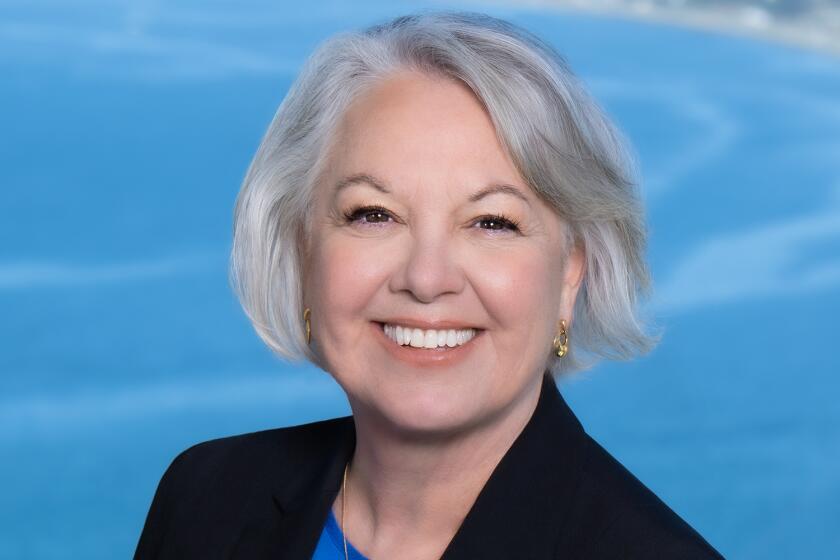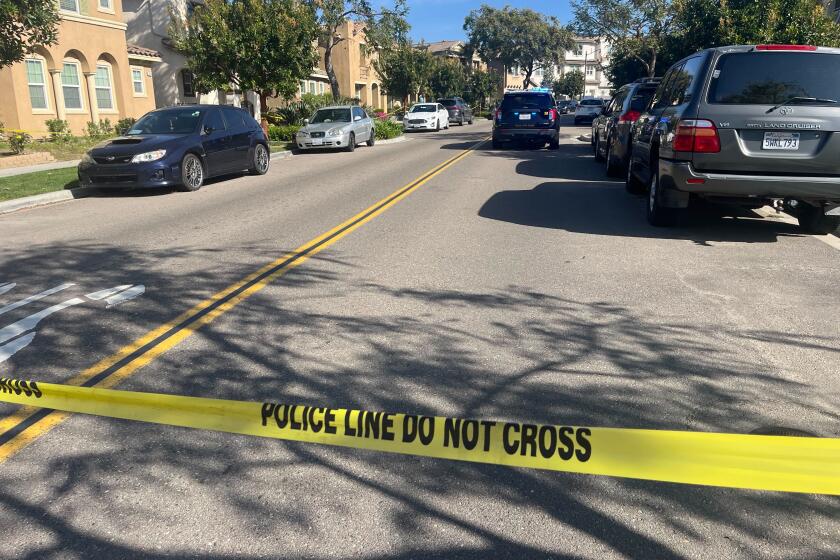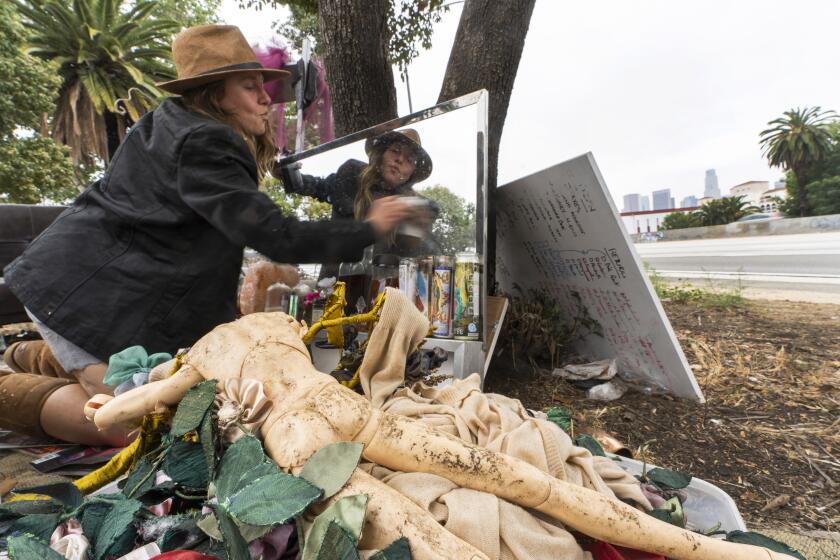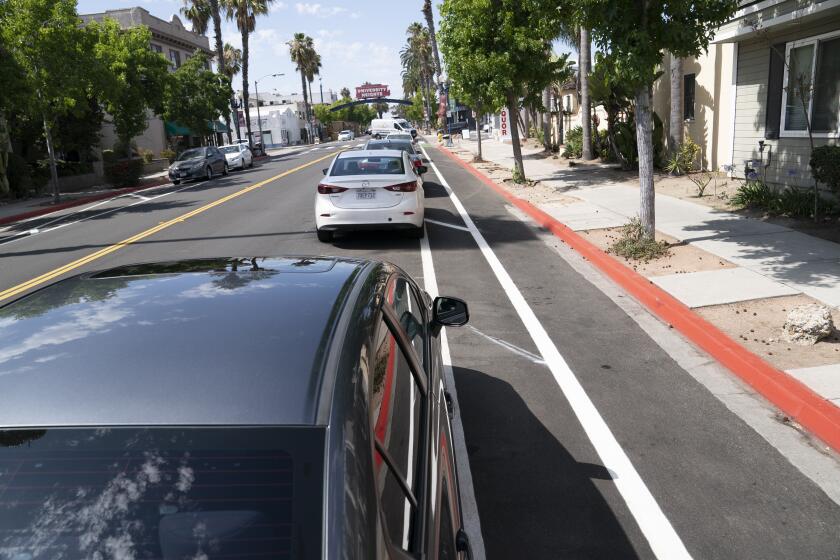Nov. 2022 Election: Q&A with John Hemmerling, candidate for San Diego County sheriff
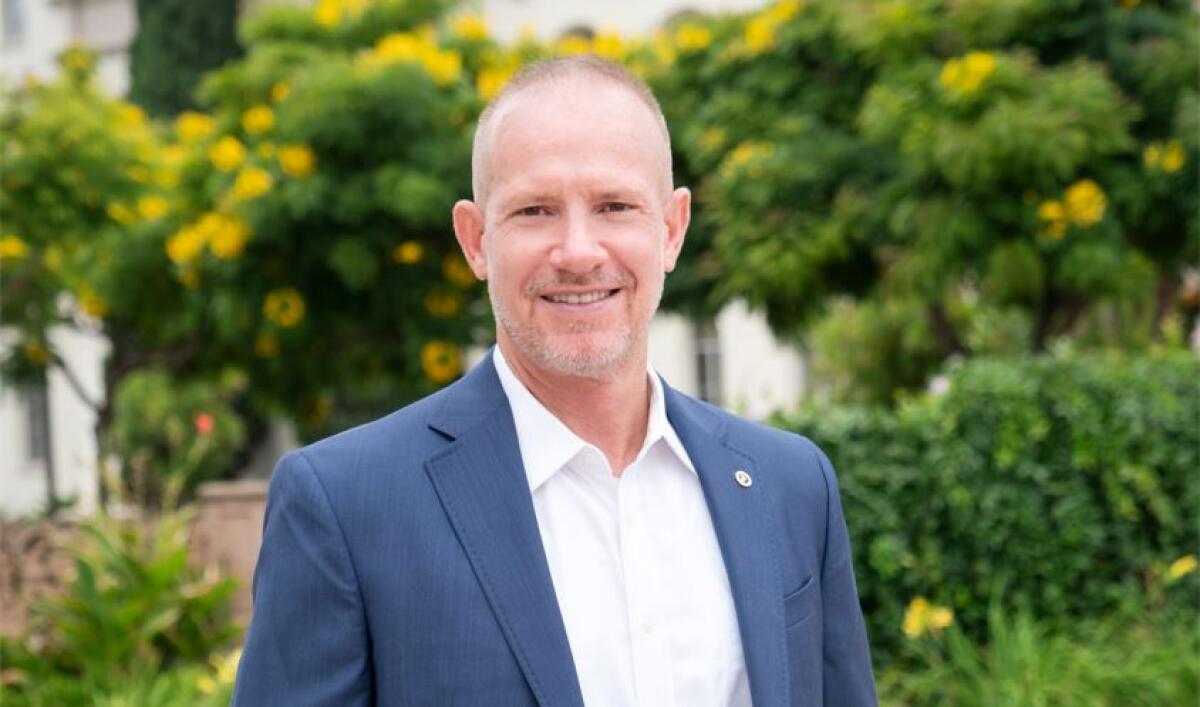
There are two candidates on the Nov. 8 ballot running to be the next San Diego County sheriff: Republican former chief criminal prosecutor John Hemmerling and Democratic undersheriff Kelly Martinez. Here are Hemmerling’s answers to a 17-question survey The San Diego Union-Tribune Editorial Board emailed candidates.
Q: What are the most pressing priorities at the Sheriff’s Department and how would you address them?
A: Restoring the public’s trust and safeguarding those in our care have to be the Sheriff’s Department’s most pressing priorities. However, we also face the significant challenges of violent crime, drug overdoses, senseless deaths in our jails and homelessness. And they all have one common root: the flood of illegal drugs like fentanyl into our communities.
Drugs destroy innocent lives. As a San Diego Police Department officer, I took a 5-year-old girl to Polinsky Children’s Center after her parents were arrested for drug sales. She put on a pretty dress and Mary Jane shoes because she thought we were going someplace special. At the center, she took a long time coming out of the restroom. She used some toilet paper without asking, an act that carried punishment in her home. I welled up as she wept in my arms. I will never forget that poor little girl.
There are two candidates on the Nov. 8 ballot running to be the next San Diego County sheriff: Democratic undersheriff Kelly Martinez and Republican former chief criminal prosecutor John Hemmerling.
Between now and early October when voting gets underway, The San Diego Union-Tribune Editorial Board is planning to publish dozens of candidate Q&As and nearly two dozen commentaries connected to a handful of San Diego city ballot measures and seven state propositions on the Nov. 8 election. Keep checking back as we fill in this voter guide.
Violent crimes, including property crimes, have risen to heights in San Diego that we haven’t seen in many years. Gun violence, home burglaries and catalytic converter theft are an everyday occurrence. I will ensure all communities, including rural and unincorporated areas, have full access to professional law enforcement, including traffic services, drug interdiction and homeless enforcement. I will immediately review all contracts for services countywide, to ensure every neighborhood receives the best law enforcement services possible.
I will bring real change and strong leadership as your new sheriff. The status quo is not good enough. I will restore honor, confidence, competence and transparency in the Sheriff’s Department.
Q: This campaign pits an experienced insider against an experienced outsider. Tell us why you’re the best fit.
A: Throughout my careers, I have learned that experience doesn’t equate to leadership. My opponent’s 37 years at the Sheriff’s Department are actually a liability. If we keep doing the same old things, we’ll keep getting the same unsatisfactory results. San Diegans deserve a different experience. We need fresh, new leadership for a real change in how we safeguard our neighborhoods, run our jails and protect victims of crime.
My career spans 28 years of dedicated service to the city of San Diego and 30 years of faithful military service. For six years, I served as the city’s chief criminal prosecutor, prosecuting thousands of misdemeanor criminal cases a year. I served as principal legal adviser to two San Diego police chiefs, including Shelley Zimmerman, who has endorsed me. I was a decorated San Diego police officer for over nine years, patrolling the toughest beats in the city. I am also a retired Marine Corps reserve colonel and a combat veteran of the Gulf and Iraq wars.
As the chief criminal prosecutor, I created programs to address gun violence (a statewide model). I implemented a program to divert drug offenders at the point of contact/arrest, allowing early intervention, at a cost savings to taxpayers. I initiated proactive filing of conservatorships for habitual users of emergency services and police. All of these innovations are now being replicated in other jurisdictions. I take action while others sit around and discuss possibilities. That is precisely what I will do as your new sheriff.
Q: Do you think the culture needs to change at the Sheriff’s Department? If so, how and why?
A: On the day Sheriff Bill Gore left office, state auditors reported that more than 100 individuals had died in his custody. The audit cited “Ongoing risk” and “Underlying systematic issues.” Despite promises from my opponent that a new era was at hand, 16 more jail-related deaths have occurred since Gore’s exit. That’s double the rate under Gore and confirms the department has a cultural problem, not just a Gore problem. It underscores the need for fresh, new leadership and sweeping change throughout the department.
At heart, this is a leadership crisis. Well-intentioned county supervisors, the Citizens’ Law Enforcement Review Board, unions, citizen groups, even lawsuits by victims’ families, have all sought to fill this leadership vacuum with proposed solutions, wiser budget priorities and constructive advice. My opponent waits for direction like a passive spectator.
In response to the ongoing risk to safety in San Diego’s jails, the state Legislature has passed Assembly Bill 2343, also known as the Saving Lives in Custody Act. It might be more appropriately called the “San Diego Jail Reform Act,” since it is intended to force my opponent to institute the very changes that the state auditors recommended in their report back in January.
Leadership counts. When I am sheriff, I will welcome constructive advice and support from any and all quarters. But as your elected sheriff, you won’t have to wait for decisions, innovation or action — you have my word on it.
Q: San Diego County has the highest rate of per-capita jail deaths in large California systems. What, specifically, will you do to address this?
A: I will do everything possible to ensure no one else dies senselessly in our jails. I will build a transition team of law enforcement experts, corrections specialists and mental health professionals to correct all the state auditor’s findings — starting on day one.
As a Marine battalion commander in Iraq, I commanded four jail compounds that processed 6,000-plus detainees — more than the pre-pandemic population of San Diego County’s jails — without incident. We provided a comprehensive medical screening of every detainee upon admission. A report to Congress lauded my tenure running jails in a war zone.
I’ll ensure behavioral health staff provide life-saving and life-preserving medical and psychiatric care to inmates, during booking and after receipt. They will provide essential screening, treatment and supervision of inmates suffering from mental illness and those with a higher risk of death due to drug overdose. I’ll ensure there are body scanners in every facility and institute strict contraband screening to keep lethal drugs such as fentanyl and methamphetamine out of our jails.
As sheriff, I’ll conduct no-notice health and safety inspections. I’ll ensure the audio intercom monitoring systems are functional at all times, so inmates may report drug overdoses, suicide attempts and other emergencies. I’ll expand video monitoring systems to ensure the widest possible coverage. And most importantly, I’ll listen to our front-line deputies and medical staff to find the best ways to stop deaths in our jails.
Q: Studies have shown that local deputies have an inequitable history of traffic stops and use of force in recent years. How would you address this and improve relationships with communities of color?
A: I served almost a decade as a San Diego police officer, serving in Mid-City — one of the highest crime beats in the county and one of the highest Black, Indigenous and people of color populations in the county. I learned firsthand that socioeconomic factors are the primary drivers of crime, including homelessness, mental illness and drug addiction. I am proud of the community connection I had there and how I took time to know and help families. Connecting with people on a personal level promoted trust and transparency.
There is no place in the Sheriff’s Department for any deputy who would allow racial (or gender) bias to interfere with the fair and just execution of their duties. Each must consider: Is the contact or use of force necessary? That must be determined on a case-by-case basis — often a split-second decision. Officer welfare and public safety cannot fall victim to a social scientist’s data sheet.
As sheriff, my ultimate goal will be protecting people’s lives. I will ask: Which communities are most impacted by crime? Is there a trend? Are they receiving adequate support? Or are they neglected because they cannot afford the same level of staffing as other neighborhoods with more money? Failing to provide adequate law enforcement to underrepresented communities is just as inappropriate as over policing. Equal protection under the law is not only a constitutional right, it’s often a matter of life or death!
Q: You made anti-transgender comments earlier in this campaign. What do you want to say to the LGBTQ community and its allies about those comments and your initial response to them? How will you ensure that transgender people interacting with the department will be treated fairly?
A: I reiterate my apology expressed to this publication in May for comments that were hurtful to the transgender community. Be assured, I will ensure that our jail housing practices align with federal and state law and that our jails’ medical and psychiatric specialists are educated on gender affirming care. As sheriff, I am fully committed to implement California’s Transgender Respect, Agency and Dignity Act, allowing incarcerated transgender, non-binary and intersex people to request to be housed and searched in a manner consistent with their gender identity.
During my 30 years of public service, I treated every individual I encountered with dignity and respect. As a beat cop, I often protected transgender people from exploitation and intimidation. As chief criminal prosecutor in San Diego, I was a leader in prosecuting hate crimes based on gender identity. Just this month, I worked with retired Sheriff’s Commander Dave Myers to connect with members of the LGBTQAI+ community to open a dialogue and hear their concerns.
What I sought to express was that a “one size fits all” approach oversimplifies a complex and sensitive issue. Requiring arrestees to be taken to a jail consistent with their gender identity makes sense; but that only gets them to the jailhouse door. All detainees must be evaluated on a case-by-case basis, including their criminal history, behavior, rehabilitation opportunities, medical and psychiatric needs (including medications) and program requirements, as well as their gender identity. My primary concern will always be safety, security and the preservation of human life.
Q: How much independence should the sheriff have in setting the department’s budget and priorities? How do you envision your relationship with the Board of Supervisors in regards to this?
A: The sheriff is independently elected by the people of San Diego County. The county charter states, “The Sheriff shall organize the Sheriff’s Department for efficient and effective law enforcement.” As such, the sheriff answers to the people, not the county Board of Supervisors, when setting law enforcement priorities.
That said, the county Board of Supervisors has the “power of the purse” when it comes to funding a department of more than 4,100 personnel with a budget of more than $1 billion. It is incumbent upon the sheriff to let the Board of Supervisors know what the department needs. They don’t know until the sheriff tells them.
On Aug. 16, the Sheriff’s Department announced the purchase of new body scanners. It stated, in part: “When Chairman Nathan Fletcher asked what more the San Diego County Board of Supervisors could do, we were happy to help shape and support a Board Action that was approved today. That action will help with the $200,000 purchase, using the Sheriff’s Department existing budget, of a new body scanner and up to eight additional scanners over the next five years.”
When I am sheriff, I won’t have to wait for county supervisors to ask me what we need — out of my own budget — to keep drugs out of the jails and keep persons alive under my care. I’ll let them know before they ask. I’ll lead that process. Fortunately, improving public safety and ending deaths in custody are goals we all share.
Q: The Sheriff’s Department has struggled to retain deputies in recent years. What specific steps would you take to address recruitment and retention problems at the Sheriff’s Department?
A: I believe more effective recruitment and retention will come when there is a renewed sense of pride in being a deputy sheriff. It’s hard serving in law enforcement these days, due to the negative press and shifting attitudes by some in the community to police officers in general. Deputies who already had felt underpaid and unappreciated felt less supported hearing “defund the police” and overreaching vaccine mandates.
The Board of Supervisors’ recent redirection of funding in the sheriff’s budget to signing bonuses, night differentials and extra pay for bilingual staff is a good start. We need to go much further. I will work with the Deputy Sheriffs’ Association to stop stagnation and improve working conditions, benefits and morale.
I will review all internal and public reports within the last 10 years related to deputy and staff recruitment and retention, to determine what isn’t working. I’m not running for sheriff to keep the status quo or give lip service to change. I want the Sheriff’s Department to be a place where people will enthusiastically want to spend their entire career.
Most disturbing are the persistent medical shortages in the jails, which allow senseless deaths to continue. As recently reported in The San Diego Union Tribune, dedicated medical staff are quitting, with inmates “suffer[ing] in what can only be described as filthy, inhumane conditions and, in some cases, [dying] by suicide.” I will personally ensure we find, retain, and — most importantly — empower medical personnel to meet the critical needs of our inmate population.
Q: Do you feel that the current staff at the department reflects the diversity of San Diego County? If not, what would you do to diversify the staff?
A: I believe the people in San Diego County want a Sheriff’s Department that reflects the community it serves. To a great extent, the Sheriff’s Department is ethnically and culturally diverse, but this is a continuous and evolving process. As sheriff, I will actively recruit the best candidates, providing the highest quality of public safety with a diverse and inclusive workforce.
Weak leadership and low morale threaten to erase these gains. In recent years, the department has experienced a significant reduction in hiring rates, a big increase in resignation rates and a massive increase in retirement rates. As retired Sheriff’s Capt. Skip Murphy recently wrote in The San Diego Union Tribune, “When staffing problems are allowed to fester, officers who can leave frequently do, leading to low morale, organizational dysfunction and enormous costs to replace them.” When staffing problems are addressed reactively, it is often too late.
When I sought to increase diversity as chief criminal prosecutor, we proactively recruited from diverse organizations, with a diverse recruitment team. They understood it was important to me. The intent of a leader must come from the top and must be clear.
Morale in the Sheriff’s Department is low. This is largely due to a vacuum in leadership at the top. I believe more effective recruitment and increased diversity will come when there is a renewed sense of trust and pride in being a deputy sheriff. To achieve that, we need a tested new leader to restore honor, confidence, competence and pride in the Sheriff’s Department.
Q: How would you balance the growing use of surveillance in law enforcement against privacy rights and equity concerns? What additional new surveillance tools would you support using?
A: Public safety and the protection of human life will be my top priority as your sheriff. These days, surveillance technology is everywhere, from cell phones to video surveillance at businesses to doorbell cameras. It is not unique to government or law enforcement. And these technologies are readily available to criminals, so they must be countered and available to law enforcement to protect public safety.
Streetlight cameras can provide critical evidence of violent street crime. Gunshot detection devices can be a valuable tool to stem the tide of gang violence and murder in some of our most underserved neighborhoods. Trail motion detector cameras can help prevent environmental damage by detecting the illegal dumping of toxic waste in our canyons and riverbeds.
The Fourth Amendment’s protection against “unreasonable searches and seizures” is intended to do more than create legal walls that mirror physical ones, and is not limited to situations where we are inside our own houses. The key is to strike the proper balance between public safety and individual privacy. I believe, with proper oversight, these new technologies can be used responsibly to protect us from crime in public places, with constitutional privacy protections fully in place.
Q: Do you think it’s appropriate to use your position to lobby state lawmakers? If so, why and on which issues would you lobby? If not, why not?
A: It is the duty of every elected official to provide evidence-based recommendations to state lawmakers to improve public safety. As sheriff, I will support legislative efforts to reform Proposition 47, which more than doubled the stolen-goods threshold under which people could be charged for felony theft, from $450 to $950. And it practically decriminalized drug crimes, removing incentives for drug defendants to seek treatment through Drug Court. We should require mandatory treatment as an alternative to criminal charges for drug use. Former San Diego Police Chief Shelley Zimmerman (who has endorsed my candidacy) called Proposition 47 “a virtual get-out-of-jail-free card.”
I will also encourage reform of Proposition 57, which was supposed to give “nonviolent” prisoners a chance at early parole. We already provided truly nonviolent offenders opportunities for rehabilitation and reintegration. However, violent criminals, including many considered “nonviolent” under Proposition 57 (including those convicted of human trafficking and domestic violence, and with dangerous criminal histories of armed robbery and attempted murder) only leave prison more violent.
I will work with the district attorney and county Board of Supervisors to lobby the state Legislature to enact legislation to stop using our rural communities as dumping grounds for sexually violent predators. Communities need a weighted voice in these decisions. I recently opposed the placement of sexually violent predators in Borrego Springs. And we now have been notified the court may allow yet another sexually violent predator to be placed in Jacumba Hot Springs. It has to stop!
Q: With the national rollout of 988, the Suicide and Crisis Lifeline, and the county’s use of mobile crisis response teams, what role should sheriff’s deputies have in mental health emergencies?
A: I fully support the expansion of Mobile Crisis Response Teams as an alternative to law enforcement to deescalate mental health crises in appropriate circumstances. However, law enforcement must respond to 911 calls when individuals become violent. Social workers should not respond in those situations.
Until San Diego County adequately addresses the lack of mental health and substance abuse disorder treatment with appropriate services like secured detox facilities that transition into supportive housing, law enforcement will always be necessary.
As chief criminal prosecutor for the city of San Diego, I was a leader in criminal justice reform. Our Community Justice Initiative was a post-plea program for low-level offenders, allowing cases to be dismissed by completing community service; participants gained access to education, job training and drug treatment. Our San Diego Misdemeanants At-Risk Track program offered drug offenders social services, individualized treatment and housing placement.
I met with members of the San Diego Asian Americans for Equality organization after the tragic shooting of Dr. Yan Li in March. The organization endorsed my candidacy after I pledged to institute de-escalation procedures to avoid mental health crises from spiraling out of control. Currently, the San Diego County’s Psychiatric Emergency Response Team consists of licensed mental health clinicians, paired with specially trained law enforcement officers and paramedics that provide proactive outreach to decrease hospitalization and incarceration, but is not available 24 hours. The Psychiatric Emergency Response Team must be fully funded and expanded to all shifts — it needs to be the rule and not the exception.
Q: What would you say to undocumented people in San Diego County who are fearful of reporting a crime to or being stopped by sheriff’s deputies?
A: Undocumented individuals should not fear reporting crime or being stopped pretextually in San Diego County when I’m sheriff. I will protect all law-abiding people in San Diego County. I won’t ask deputies to perform the stated missions of Immigration and Customs Enforcement (ICE) and Customs and Border Protection (CBP) — that would distract from fighting crime in our neighborhoods.
Notifications and transfers related to criminal violations of the law will be made in accordance with California state law. Information regarding all prisoners in the sheriff’s custody will be public information, unless safety or security concerns warrant withholding that information. I will ensure the stated law and intent of the Values Act are enforced.
At the same time, I will not impede the ability of ICE and CBP to enforce federal laws at our border. I will assist ICE, CBP and all other law enforcement agencies to apprehend and prosecute criminals on an emergency, mutual aid basis. I will take aggressive action against those who commit any crimes along our southern border.
I am committed to working with federal, state and local law enforcement partners to stop the flood of illegal drugs across our southern border. Last year, overdose fatalities surged 33 percent in San Diego County — to more than 1,300 overdose deaths! County supervisors have correctly called fentanyl a public health crisis. But the first line of defense is to cut off the supply of drugs at its source, with tough, aggressive law enforcement at the border!
Q: There is a problem with drugs in county jails. Who should be subjected to body scans before entering the jails? Should deputies and department staff be among those who are scanned?
A: In an attempt to fill the leadership vacuum at the Sheriff’s Department, the Citizens’ Law Enforcement Review Board has suggested jail personnel physically search or body scan all persons entering a detention facility, including all employees, contractors and visitors, during booking and transfers, and when reentering the jails after court, medical treatment, etc.
The Sheriff’s Department currently employs body scanners at some facilities during the booking process and is in the process of purchasing others. I agree with the Citizens’ Law Enforcement Review Board that all inmates and all visitors (including lawyers) should be scanned anytime they enter a secure area, to include returning to the facility from family visits, medical appointments, court, etc. While this will be a burden at first, requiring additional equipment and training, it will pay dividends in the long run by keeping drugs and other dangerous contraband out of the jails.
Sheriff’s staff should be subject to random screening, after agreeing through meet and confer obligations under the contracts with the affected unions.
Further, I will treat drug smuggling into the jails as serious felony criminal investigations. I will use crime analysts to identify patterns by time and location of overdoses, staff and inmates present, and unusual money transactions or stores purchases by inmates. I will employ our full investigative resources to catch drug smugglers, including narcotics detectives, confidential informants, dogs, random cell searches and Crime Stoppers rewards. I will restore honesty and transparency, promptly reporting the results of our investigations to affected families, the media and the public.
Q: The former sheriff was criticized for limiting concealed-carry weapon permits. Would your approach be strict or lenient to issuing permits, and how would you define “good cause”?
A: Individuals have the right to keep and bear arms. Individuals also expect the process to be fair and transparent. This has not always been the case in San Diego. We have read the recent stories of bribery, favoritism and back-door dealings. That ends when I’m sheriff.
We will issue concealed-carry permits to all persons who complete the required training and demonstrate good moral character by passing the required background investigation. Every applicant who meets the state’s statutory requirements will get the permit. The process will be clear, fair, transparent and efficient.
In June, the U.S. Supreme Court affirmed what I have said about “good cause” all along: Constitutionally protected rights such as the Second Amendment’s right to keep and bear arms must be made equally available to all responsible citizens, without arbitrary or biased discretion, allowing every individual to assess their own need for personal safety or self-defense.
The best way to ensure the right to bear arms for responsible gun owners is to remove guns from criminals and the insane. The attorney general recently praised the San Diego city attorney’s gun violence prevention programs as the best in California. However, my opponent is reluctant to use tools to prevent gun violence that are used effectively and fairly by other police chiefs and sheriffs statewide. As sheriff, I will use every law on the books, with complete due process in court, to deny those who pose a grave risk to public safety access to firearms.
Q: County supervisors allow the Sheriff’s Department to use military-grade equipment such as armored vehicles. How can you guarantee that this equipment will be used responsibly?
A: In April, the county Board of Supervisors unanimously approved the continued use of a wide range of military-grade equipment, including beanbag shotguns, armored vehicles, drones, flash bangs, tear gas and tactical robots. This equipment is largely used by the SWAT team during critical incidents or tactical operations, although patrol, courthouse and jail deputies are also equipped with less-lethal weapons, such as beanbag shotguns and pepper ball launchers.
As sheriff, it will be useful to have authorization for such equipment from the county Board of Supervisors. However, just because we have the authority does not mean the equipment needs to be acquired or used. We will determine that on a case-by-case basis. A prudent leader prepares for a wide range of contingencies, within fiscal constraints. It is far better to have something and not need it than to need it and not have it.
I am the only candidate who has trained and commanded Marines in combat, as well as rookie cops as a San Diego Police Department field training officer. Ironically, I was the only Marine commander to request and successfully use tasers in Iraq — less lethal, law enforcement grade equipment, in a military war setting. I saved lives, reduced injury to Marines, and set a new standard.
I will not be a passive observer. I will ensure these tools are only used in appropriate circumstances, when they can tilt the balance against dangerous criminals and save lives in our communities.
Q: Why should you be elected over your opponent?
A: I am clearly the best choice for sheriff — to fight crime and restore trust and confidence for safer communities. As chief criminal prosecutor, a combat Marine veteran and a former San Diego police officer, I am uniquely qualified to lead the Sheriff’s Department across the entire spectrum of criminal justice — from the streets to the courtroom to jail.
I was a fair, compassionate beat cop in the county’s most challenging neighborhoods. As a colonel, I inspired Marines to take initiative and solve problems. I will reduce violent crime — putting victims and communities first. I will ensure equal access to responsive law enforcement for all San Diegans. I will halt the flood of fentanyl and other illegal drugs into our communities. I will end the senseless deaths in our jails. Public safety will be my top priority.
During the primary, 62.5 percent of voters showed they wanted a change at the Sheriff’s Department by voting for someone other than my opponent. They rejected the status quo. I will set the higher standard they seek. There is an old saying that “a new broom sweeps clean.” I will restore honor, confidence, competence and transparency. I will bring real change and strong leadership as your new sheriff.
Key endorsements include Mayors Richard Bailey (Coronado), Bill Wells (El Cajon) and John Minto (Santee); former Mayor Kevin Faulconer (San Diego), county Supervisor Joel Anderson, former San Diego Police Chief Shelley Zimmerman, the San Diego Deputy City Attorneys Association, Asian Americans for Equality and the Latino-American Political Association.
Visit hemmerlingforsheriff.com and vote Hemmerling for sheriff!
Get Weekend Opinion on Sundays and Reader Opinion on Mondays
Editorials, commentary and more delivered Sunday morning, and Reader Reaction on Mondays.
You may occasionally receive promotional content from the San Diego Union-Tribune.
